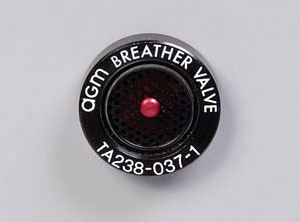
The greatest strength of the well-constructed transit case is also its greatest weakness. An airtight seal keeps moisture and dust at bay but can lead to a significant pressure differential. If the case becomes pressurized—say you close it at night and leave it in the desert sun all day—the sides might bulge, and the seal could give way. Alternatively, closing it on a mountain top and driving to the coast will create a partial vacuum. The case will be difficult to open. The sides could even indent.
Making the case stronger also makes it bigger and heavier. In fact, sometimes a case will weigh more than the payload. Fortunately, there is an alternative.
A Pressure Relief Valve or PRV (also called a breather valve) is two valves in one package. 1.) When the pressure in the case is higher than outside it opens to let air out. 2.) When the outside pressure is higher it lets air in.
Springs inside the PRV open and close the valve in response to a pressure differential. When the difference exceeds the spring load, the valve opens, allowing air to flow. As the differential falls below the spring load the valve closes again.
A PRV opens at slightly different pressure differentials, depending on the direction of the difference. This needs to be taken in to account when matching a PRV to a case, as should the PRV’s air flow rates. A valve that opens at a low differential lets a case breathe more often than one needing a greater pressure difference. And, the longer a valve stays open, the more moisture can enter.
Moisture can be absorbed by a desiccant, but the more the case breathes the more moisture will be introduced. The desiccant has a finite capacity. So, extended protection means minimizing air exchange.
Many of the valves used by Sierra Cases have a manual release button. This allows the pressures to equalize. This makes it possible to open a case at partial vacuum, and avoid the risk of injury when the contents are pressurized.
A good transit case provides an airtight seal. But, that can be a problem. A PRV matched to the application minimizes the air drawn in while protecting the contents and keeping case weight and size to a minimum.
Part 1: Pressure Relief Valves: The Smart Way to Handle Pressure Changes